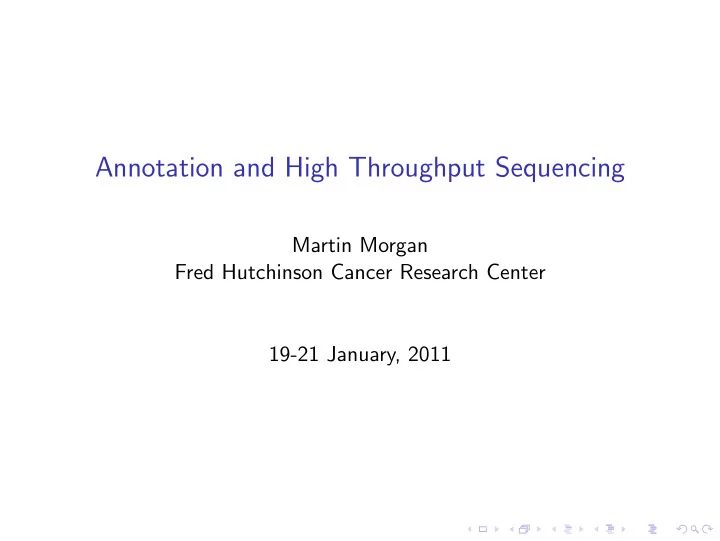

Annotation and High Throughput Sequencing Martin Morgan Fred Hutchinson Cancer Research Center 19-21 January, 2011
Annotation Resources – Genes and Genomes AnnotationDbi ◮ Chip, ‘org’, GO, KEGG, homology ◮ Curated from NCBI, GO, other sources for each Bioconductor release. ◮ SQL ‘under the hood’ biomaRt ◮ Large online annotation collection ◮ Curated by OICR / EMBL-EBI BSgenome ◮ Genome sequences – try available.genomes
Demo AnnotationDbi , biomaRt
Work Flow: Sequence Analysis Prior to analysis ◮ Biological experimental design – treatments, replication, etc. ◮ Sequencing preparation – library preparation, manufacturer protocol, etc. Analysis 1. Pre-processing (sequencing, alignment, quality assessment) 2. Count, e.g., reads per transcript – ChIP-seq; RNA-seq; novel transcript identification; microbiome; . . . 3. Differential representation / ChIP-seq / SNP / . . . 4. Annotation 5. . . . http://bioconductor.org/workflows for common analyses.
Bridge PCR Bentley et al., 2008, Nature 456: 53-9
Bioconductor entry points ◮ Quality assessment. ◮ Preliminary read processing, e.g., demultiplexing, remediation ◮ Specialized alignment, e.g., matchPDict in Biostrings . ◮ ‘Upstream’ domain-specific work flows, e.g., ChIP-seq peak calling ( chipseq ), RNA-seq reads per transcript ( GenomicRanges / IRanges / . . . ) ◮ Statistical analysis of designed experiments, e.g., edgeR , DESeq ◮ Specialized analysis, e.g., microbiome sequence processing and ecological analysis ( vegan , ape , . . . )
Sequence I/O Packages Biostrings DNA sequence, pattern matching Rsamtools BAM manipulation ShortRead ‘traditional’ aligned reads; quality assessment rtracklayer GFF and other formats; browser interaction GenomicRanges Regions of interest / aligned reads as collections of ranges on genomes Functions ◮ readFasta , readFastq , writeFasta , writeFastq ◮ scanBam (also sort, index, filter BAM files; BCF, indexed fasta) ◮ import / export (for GFF & friends) ◮ readAligned , readGappedAlignments
Representing Sequence Information DNAStringSet ◮ Collections of DNA sequences, e.g., microarry probes, Illumina reads ◮ Quality scores GRanges ◮ Genome coordinates – reference sequence name, start and end coordinates, strand; e.g., aligned reads ◮ GRangesList – hierarchical structure, e.g., exons within transcripts Additional classes: AlignedRead , GappedAlignment , . . .
Sequence Annotations ◮ Existing infrastructure for gene-level annotation GenomicFeatures ◮ Idea: retrieve annotations from common sources, e.g., UCSC genome browser ‘known genes’ track; save as a local data base. ◮ Query for regions of interest, e.g., exons per transcript
Demo DNAStringSet , GRanges , AlignedRead and GappedAlignment , GenomicFeatures
Lab activity Goal: Explore sequences and their annotation 1. Data input and exploration 2. Gapped alignments 3. Transcript annotations 4. Counting reads aligned to regions 5. (Differential representation) 6. Annotation to biological function
Example Data Nagalakshmi et al., 2008. The transcriptional landscape of the yeast genome defined by RNA sequencing, Science 320: 1344–1349 [ ? ]. ◮ Original ‘RNA-seq’ experiment ◮ Two different primers to generate DNA from poly(A) RNA: RH Random hexamer dT oligo(dT) ◮ Biological and technical replicates ◮ Illumina GAI – relatively small number ( < 5 million / lane) of short (33bp) reads; poor trailing base quality.
Recommend
More recommend